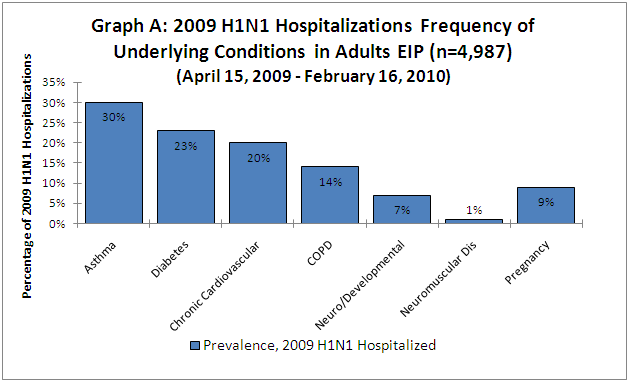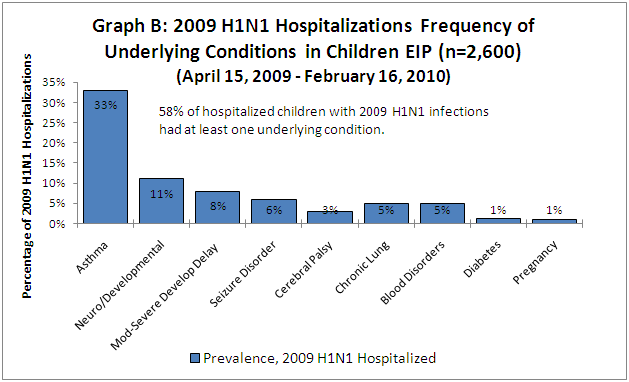2009 H1N1 Flu: Underlying Health Conditions among Hospitalized Adults and Children
February 24, 2010, 6:30 PM ET
This Q&A provides updated information about underlying health conditions among hospitalized 2009 H1N1 patients in the United States as reported to CDC from April 15, 2009 – February 16, 2010. CDC first reported information about underlying health conditions related to 2009 H1N1 hospitalizations on July 31, 2009.
How does CDC track underlying health conditions among people hospitalized with 2009 H1N1 flu?
CDC collects data on 2009 H1N1 flu-related hospitalizations, through the Emerging Infections Program (EIP) and the Aggregate Hospitalizations and Deaths Reporting Activity (AHDRA). Of the two systems, however, EIP is the only one that routinely captures information related to underlying health conditions. EIP conducts weekly surveillance for laboratory-confirmed influenza-related hospitalizations in children (defined as persons younger than 18 years) and adults in over 60 counties covering 13 metropolitan areas of 10 states. EIP identifies influenza-related hospitalizations by reviewing hospital laboratory and admission databases and infection control logs for children and adults with a positive influenza test conducted as a part of routine patient care. EIP then compiles information related to patients’ underlying conditions by conducting chart reviews. For more information about EIP see the overview of influenza surveillance in the United States.
What percentage of people hospitalized with 2009 H1N1 Flu have an underlying health condition?
According to EIP data collected from April 2009 to February 16, 2010, 85% of hospitalized adults and 58% of hospitalized children with 2009 H1N1 virus infections have had one or more medical conditions.
Has there been a change in the underlying conditions associated with 2009 H1N1 hospitalization since spring 2009?
EIP hospitalization data collected from April 15, 2009 – February 16, 2010, shows that the majority of people hospitalized from 2009 H1N1 flu have at least one underlying health condition. This is consistent with data collected in spring 2009. See Graph A and B below for a visual representation of underlying health conditions in 2009 H1N1 hospitalized adults and children in the United States.

Graph A shows EIP hospitalization data for adults. At 30%, asthma is the most common underlying health condition reported among adult 2009 H1N1 hospitalizations. Diabetes is the second most common underlying condition associated with 2009 H1N1 hospitalization, accounting for 23% of those hospitalizations in adults. Chronic cardiovascular disease (CVD) accounts for 20% of 2009 H1N1 hospitalizations in adults. Chronic obstructive pulmonary disease (COPD) accounts for 14% of 2009 H1N1 hospitalizations in adults. Pregnancy accounts for 9% of 2009 H1N1 hospitalizations in adult women. Neurological/developmental disabilities account for 7% of 2009 H1N1 hospitalizations in adults. And lastly, neuromuscular disorders account for 1% of 2009 H1N1 hospitalizations in adults.

*In Graph B, neurological/developmental disorders are not inclusive of cerebral palsy cases, which have been separated into a different category.
Graph B shows EIP hospitalization data for children. As it is in adults, asthma is the most common underlying health condition reported among 33% of children hospitalized with 2009 H1N1. Neurological/developmental disabilities are the second highest reported condition in children and account for 11% of 2009 H1N1 hospitalizations in children. Moderately severe developmental delay conditions account for 8% of 2009 H1N1 flu related hospitalizations in children. Seizure disorders account for 6% of 2009 H1N1 flu related hospitalizations in children. Cerebral palsy accounts for 3% of 2009 H1N1 flu related hospitalizations in children. Chronic lung conditions account for 5% of 2009 H1N1 flu related hospitalizations in children. Blood disorders, such as sickle-cell anemia, account for 5% of 2009 H1N1 flu related hospitalizations in children. Diabetes accounts for 1% of 2009 H1N1 flu related hospitalizations in children. And lastly, pregnancy accounts for 1% of 2009 H1N1 hospitalizations in children.
Where can I find a complete list of underlying health conditions that place people at higher risk for flu-related complications?
CDC has published a list of people at high risk for developing flu-related complications.Get email updates
To receive weekly email updates about this site, enter your email address:
Contact Us:
- Centers for Disease Control and Prevention
1600 Clifton Rd
Atlanta, GA 30333 - 800-CDC-INFO
(800-232-4636)
TTY: (888) 232-6348 - Contact CDC-INFO